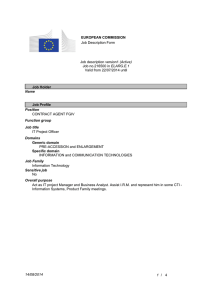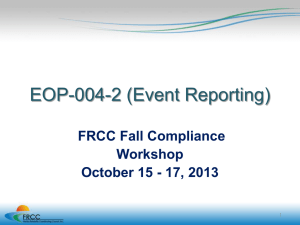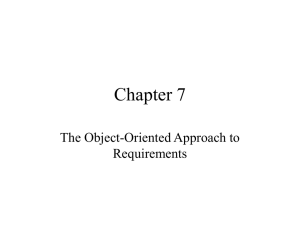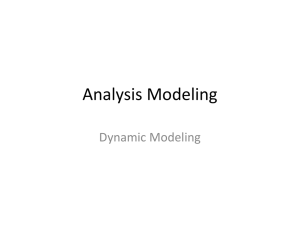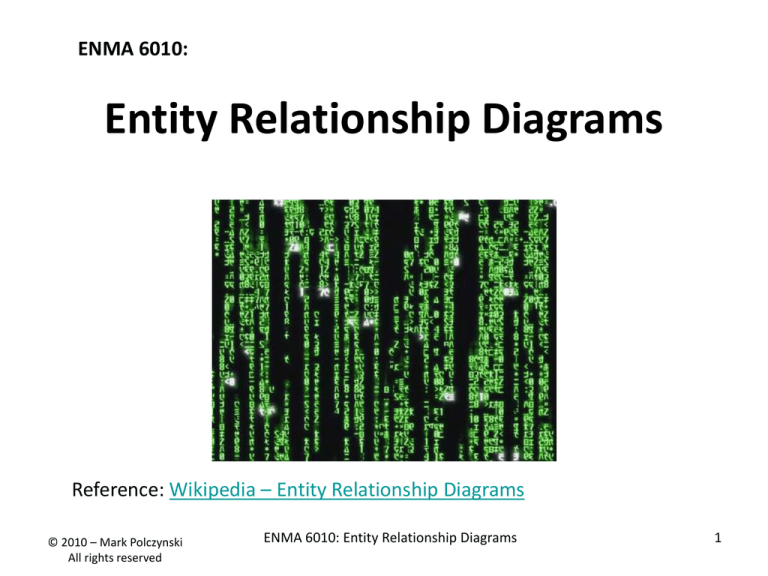
ENMA 6010:
Entity Relationship Diagrams
Reference: Wikipedia – Entity Relationship Diagrams
© 2010 – Mark Polczynski
All rights reserved
ENMA 6010: Entity Relationship Diagrams
1
Goals of System Modeling:
1.
To focus on important system features while downplaying less
important features,
2.
To verify that we understand the user’s environment,
3.
To discuss changes and corrections to the user’s requirements at low
cost and with minimal risk,
4.
To verify that we have documented our understanding in a way that
would allow others to construct/maintain the system.
ENMA 6010: Entity Relationship Diagrams
2
Characteristics of Good Models:
1.
Graphical, with support for detailed text descriptions: Picture is worth a
thousand words picture links to a thousand words.
2.
Top-down partitionable: Globe Continents Countries etc…
3.
Minimally redundant: Make changes in just one place in the model.
4.
Transparent: Requires no expertise in model building to understand the
model.
ENMA 6010: Entity Relationship Diagrams
3
PFD vs. DFD vs. STD vs. ERD
ERD
Start
STD turns on DFD,
Causes PFD to execute
Object A
Activity 1
Object C
Control Flow 1
Decision?
Object A
Function X
Object C
Object B
Object C
Activity 3
Activity 2
Object B
Activity 4
Objects C
ERD
End
ENMA 6010: Entity Relationship Diagrams
4
Modeling tools we will be using in this course:
Why do we
need all
these
models?!
•
Context Diagram: Scope and boundaries of model.
•
Data Flow Diagram: Movement of data and materials – What?
•
State Transition Diagrams: Transitions between system wait states - When?
•
Process Flow Diagrams: Actions and decisions – How?
•
Entity Relationship Diagram: Information stores – Which?
•
Causal Loop Diagram: System cause and effect relationships.
•
IBIS Analysis: Description of “fuzzy” decisions.
•
Monte Carlo Simulation: Entity flow and resource utilization.
ENMA 6010: Entity Relationship Diagrams
5
Different models reveal different
aspects of the system we are
modeling.
Some are not as useful as others,
but you may not know which is
most useful when you start.
ENMA 6010: Entity Relationship Diagrams
6
Where do we start?!
An experienced system analyst approaching a new system is confronted with
the same dilemma that a new system analyst faces:
Where to start the analysis?
This course introduces a number modeling and
analysis tools and processes suitable for application
to a wide range of systems.
In terms of an optimal sequence of application of
these approaches, the best answer is, of course:
Apply them all at once!
ENMA 6010: Entity Relationship Diagrams
7
Start With Genchi Genbutsu:
•
Genchi genbutsu is a principal of lean thinking which roughly
translates to: “Go and see for yourself”.
•
A good place to start your system analysis is to go out and talk to
current or perspective system users to see “how things get done”.
•
As you interview people, you will be taking notes
on what you hear and see.
•
In this course, we capture this info in a basic process
flow diagram, to which we add detail as we apply
other modeling techniques to the system.
•
The entity relationship diagram is another excellent tool for capturing
this information.
ENMA 6010: Entity Relationship Diagrams
8
Where should you start?!
•
As you gain experience using different system modeling tools, you will, in
fact, apply them all at the same time to capture a description of the
system you are analyzing.
•
However, with experience, you may find it beneficial to entity
relationship diagrams first.
•
This tool helps to systematically capture the information obtained
through interviews in a standardized format.
•
The tool also reveals gaps and inconsistencies in your description of the
system that you will want to correct early in your analysis.
•
But the ERD can be difficult to grasp, so we have delayed discussing it
until after presenting some more (hopefully!) intuitive tools.
ENMA 6010: Entity Relationship Diagrams
9
Simple Example – Hospital System Model
Here is a portion of your notes taken while
interviewing staff in a hospital:
• Patients are assigned to a ward, and are
treated by doctors.
• Wards contain beds occupied by patients.
• Nurses work in a ward, where they attend to patients.
• Patients consume medications dispensed by nurses.
This simplified narrative description of a hospital system is derived
from http://www.umsl.edu/~sauter/analysis/er/er_intro.html
We will use the description to illustrate the primary elements of
entity relationship (ER) models.
ENMA 6010: Entity Relationship Diagrams
10
Simple Example – Hospital System Model
Here is a portion of your notes taken while interviewing staff in a hospital:
• Patients are assigned to a ward, and are treated by doctors.
• Wards contain beds occupied by patients.
• Nurses work in a ward, where they attend to patients.
• Patients consume medications dispensed by nurses.
When creating an ER model, your primary focus is on on:
•
“Things” (entities) in the system about which the system needs to
store information, and…
•
What information needs to be stored for each entity.
ENMA 6010: Entity Relationship Diagrams
11
Common types of entities about which systems need to store information:
•
Tangible objects - MRI machine, lab report
•
Roles played - Patient, doctor
•
Organizational units - Ward, admissions
•
Sites/locations - Factory, warehouse
•
Events - Purchase, payment
Relationship to DFD:
- DFD models flow of data and materials,
- ERD models stored information about data and materials.
ENMA 6010: Entity Relationship Diagrams
12
PFD vs. DFD vs. STD vs. ERD
ERD
Start
STD turns on DFD,
Causes PFD to execute
Object A
Activity 1
Object C
Control Flow 1
Decision?
Object A
Function X
Object C
Object B
Object C
Activity 3
Activity 2
Object B
Activity 4
Objects C
ERD
End
ENMA 6010: Entity Relationship Diagrams
13
Identifying Entities Generally speaking, entities are nouns, so lets find some nouns in the text
description of the hospital…
• Patients are assigned to a ward, and are treated by doctors.
• Wards contain beds occupied by patients.
• Nurses work in a ward, where they attend to patients.
• Patients consume medications dispensed by nurses.
That was easy!
What next?
ENMA 6010: Entity Relationship Diagrams
14
Attributes:
We said that entities are elements of our system for which we need to store
information.
An entity’s attributes are the individual items of information that we need
to store.
For example, a patient in the hospital has:
• Name
• Birth date
• Gender
• Height
• Weight
Note that a patient also has a particular eye color, but this hospital system
doesn’t need to store this information, so it is not an attribute of this entity.
ENMA 6010: Entity Relationship Diagrams
15
Key Attributes
•
Often, different entities will have the same types of attributes.
•
So, both patients and doctors have birth days,
And a patient may even have the same birthday as their doctor.
•
But every entity must have one attribute that uniquely identifies the
entity.
•
So, both patients and doctors may have social security numbers,
But they never have the same social security number.
•
Thus, for this system, social security number is a key attribute.
It can’t be that simple!
What else do we need?
ENMA 6010: Entity Relationship Diagrams
16
Relationships:
Relationships describe how entities are related to one another, e.g. a
doctor examines a patient, and a patient is examined by a doctor.
To find relationships, just look for the verbs in your text description…
• Patients are assigned to a ward, and are treated by doctors.
• Wards contain beds occupied by patients.
• Nurses work in a ward, where they attend to patients.
• Patients consume medications dispensed by nurses.
ENMA 6010: Entity Relationship Diagrams
17
Note: Arena simulation software also uses the concepts of entity and attribute.
Also, Arena resources are a kind of entity in ER diagrams.
Don’t worry about this stuff for now, let’s just keep going…
Entities are the things that flow through the process we are modeling.
• They are the things that get worked on by the process.
• Different types of entities can be flowing through the process.
Attributes are characteristics that are common to all entities of the same type.
• Entities may have many different characteristics, but attributes are just the
ones that we care about in the model.
• For now, our entities have just two attributes: arrival time and service time.
Resources are the things that do the work on the entities.
• Just as there can be multiple types of entities in a model, there can be
multiple types of resources.
• More than one resource or one type of resource may be needed to work on
an entity.
ENMA 6010: Entity Relationship Diagrams
18
So what we know so far is that entity relationship models consist of:
•
Entities, which have attributes,
•
Relationships, which describe how entities are related to one another.
All we need to do now is to convert all this into a diagram.
So let’s do it!
ENMA 6010: Entity Relationship Diagrams
19
You may have already seen a simple form of ER diagram…
Structured (Indented) Bill-Of-Materials:
Assembly
Sub-Assembly 1
Component A
Sub-Assembly 2
Component B
Component C
•
Assembly uses Sub-Assemblies 1, 2….
•
Sub-Assembly 1 uses Components A, B, C…
This diagram simply describes the “uses” relationship between assemblies,
sub-assemblies, and components.
ENMA 6010: Entity Relationship Diagrams
20
Here’s another simple form of ER diagram…
Org Chart:
CEO
Vice President of
Marketing
Northeast Regional
Sales Manager
Vice President of
Engineering
Southeast Regional
Sales Manger
•
VPs report to CEO
•
Sales Managers report to VP of Marketing
The org chart shows the “report to” relationships among staff positions.
ENMA 6010: Entity Relationship Diagrams
21
Here’s What Goes Into an ER Diagram:
Entity
(Object)
Relationship
Attribute
Noun, “things” often grouped into sixclasses: Roles, events,
locations, physical items, devices, organizational units. May be
termed “object”.
Verb (verb phrase) which describes how entities (objects)
are related to one another, e.g. a doctor examines a patient,
and a patient is examined by a doctor.
Noun, which characterizes an entity, e.g. a doctor has a
name, and examines a patient with a name.
ENMA 6010: Entity Relationship Diagrams
22
Here is the General Form of an ER Diagram:
Attribute 1.1
Entity 1
Relationship
A
Entity 2
Attribute 1.2
Attribute 2.1
Attribute 2.2
ER Diagrams have Entities, Relationships, and Attributes.
Often times, Entities are termed Objects.
ENMA 6010: Entity Relationship Diagrams
23
Here is an Example:
Simple model of a patient-doctor relationship:
Name*
Condition
Name*
Patient
Examined By
Examines
Doctor
Specialty
* Indicates a key attribute
ENMA 6010: Entity Relationship Diagrams
24
Relationships are always bi-directional:
Name
Condition
Name
Patient is examined by a Doctor
Patient
Examined By
Examines
Doctor
Specialty
Doctor examines a Patient
There is a simpler way to show this…
ENMA 6010: Entity Relationship Diagrams
25
Simplified notation:
Arrow shows
how to read
relationship
Name
Condition
Patient
Examined By
Name
Doctor
Specialty
Patient is examined by a Doctor
The arrow simply shows how to read the relationship.
The arrow has nothing to do with flow,
since nothing “flows” in an ER diagram.
ENMA 6010: Entity Relationship Diagrams
26
Simplified notation:
Arrow shows
how to read
relationship
Name
Condition
Patient
Examines
Name
Doctor
Specialty
Doctor examines Patient
This diagram is exactly equivalent to the diagram on the previous slide.
ENMA 6010: Entity Relationship Diagrams
27
Here is an even more simplified ER notation that we will use:
Entity
Attributes
Doctor
- Name*
- Specialty
Relationship
Examines
Patient
- Name*
- Condition
Direction
* Indicates a key attribute
ENMA 6010: Entity Relationship Diagrams
28
In Visio, go here
for ER diagrams
It’s convenient to draw
simplified ER diagrams
in Visio
ENMA 6010: Entity Relationship Diagrams
29
My favorite
ER shapes…
Entity 1
Attribute 1
Attribute 2
ENMA 6010: Entity Relationship Diagrams
Entity 2
Relationship
Attribute 1
Attribute 2
30
So now we know what the basic elements of an ER model are,
And also the basic components of an ER diagram.
Let’s walk through the construction of a diagram
using our hospital example…
ENMA 6010: Entity Relationship Diagrams
31
Identifying Entities Noun, “things” often grouped into six classes: Roles, events, locations,
physical items, devices, organizational units. May be termed “object”.
• Patients are assigned to a ward, and are treated by doctors.
• Wards contain beds occupied by patients.
• Nurses work in a ward, where they attend to patients.
• Patients consume medications dispensed by nurses.
To help keep track of things, let’s put this into a matrix format…
ENMA 6010: Entity Relationship Diagrams
32
Entity-Entity Matrix – Step 1: Entities
Patients
Doctors
Nurses
Wards
Beds
Meds
Patients
Doctors
Nurses
Wards
Beds
Meds
All we need to do here is go back to the narrative, pull out all the entities,
and put them on the axes of the matrix.
ENMA 6010: Entity Relationship Diagrams
33
Identifying Relationships:
Relationships describe how entities are related to one another.
To find relationships, just look for the verbs in your text description…
• Patients are assigned to a ward, and are treated by doctors.
• Wards contain beds occupied by patients.
• Nurses work in a ward, where they attend to patients.
• Patients consume medications dispensed by nurses.
ENMA 6010: Entity Relationship Diagrams
34
Entity-Entity Matrix – Step 2: Relationships
Patients
Patients
Doctors
Nurses
Wards
Beds
Meds
Treated by
Attended by
Assigned to
Occupy
Consume
Doctors
Nurses
Wards
Beds
Meds
Work in
Contain
Dispense
Now, we go back to the narrative,
pull out all the verbs, and put them
in the appropriate cells in the matrix.
Note: We are just showing
the relationships in one
direction, so only half the
matrix needs to be filled in
ENMA 6010: Entity Relationship Diagrams
35
Here’s our basic ER diagram in matrix form with entities and relationships:
Patients
Patients
Doctors
Nurses
Wards
Beds
Meds
Treated by
Attended by
Assigned to
Occupy
Consume
Doctors
Nurses
Wards
Beds
Meds
Work in
Contain
Dispense
• Patients are assigned to a ward, and are treated by doctors.
• Wards contain beds occupied by patients.
• Nurses work in a ward, where they attend to patients.
• Patients consume medications dispensed by nurses.
ENMA 6010: Entity Relationship Diagrams
36
Here’s our basic ER diagram in matrix form with entities and relationships:
Patients
Patients
Doctors
Nurses
Wards
Beds
Meds
Treated by
Attended by
Assigned to
Occupy
Consume
Doctors
Nurses
Wards
Beds
Meds
Work in
Contain
Dispense
Hey! What’s with
these blank cells?!
Are Doctors related to Meds?
Are Wards related to Meds?
What about all the other blank cells?
ENMA 6010: Entity Relationship Diagrams
37
Entity-Entity Matrix – Step 3: Validation
Patients
Patients
Doctors
Nurses
Wards
Beds
Meds
Treated by
Attended by
Assigned to
Occupy
Consume
Doctors
Nurses
Wards
Beds
Meds
Work in
Perscribe
Dispense
Contain
Stock
Missed
Missed in
in original
original
verbal
description!
description!
Here are two relationships missed in the initial system description.
An advantage of the matrix approach is that it allows thorough examination
of all potential relationships.
Now let’s build the diagram!
ENMA 6010: Entity Relationship Diagrams
38
Building the Diagram:
Just for fun, let’s pretend the doctor-patient relationship is the most
important part of our system, so let’s start there…
Patient
Patients
Patients
Doctors
Nurses
Wards
Beds
Meds
Treated by
Attended by
Assigned to
Occupy
Consume
Treated by
Doctors
Nurses
Doctor
Wards
Beds
Meds
Work in
Perscribe
Dispense
Contain
Stock
ENMA 6010: Entity Relationship Diagrams
39
Building the Diagram:
Nurses are pretty important, too, so let’s add them next…
Patient
Treated by
Doctor
Attended by
Nurse
Patients
Patients
Doctors
Nurses
Wards
Beds
Meds
Treated by
Attended by
Assigned to
Occupy
Consume
Doctors
Nurses
Wards
Beds
Meds
Work in
Perscribe
Dispense
Contain
Stock
ENMA 6010: Entity Relationship Diagrams
40
Now let’s throw in Wards…
Assigned to
Patient
Ward
Doctor
Attended by
Works in
Patients
Patients
Doctors
Nurses
Wards
Beds
Meds
Treated by
Treated by
Attended by
Assigned to
Occupy
Consume
Doctors
Nurse
Nurses
Wards
Beds
Meds
Work in
Perscribe
Dispense
Contain
Stock
ENMA 6010: Entity Relationship Diagrams
41
Now add Beds…
Occupies
Bed
Contain
Assigned to
Patient
Ward
Doctor
Attended by
Works in
Patients
Patients
Doctors
Nurses
Wards
Beds
Meds
Treated by
Treated by
Attended by
Assigned to
Occupy
Consume
Doctors
Nurse
Nurses
Wards
Beds
Meds
Work in
Perscribe
Dispense
Contain
Stock
ENMA 6010: Entity Relationship Diagrams
42
Now add Medications…
Bed
Occupies
Contains
Assigned to
Patient
Ward
Attended by
Works in
Stocks
Treated by
Doctor
Consumes
Nurse
Prescribes
Dispenses
Medication
So, that completes our basic ER diagram for our hospital system analysis.
ENMA 6010: Entity Relationship Diagrams
43
This is the basic idea behind ER diagrams, now let’s add some detail:
•
Entity dictionary,
•
Cardinality,
•
Logical model vs. physical model,
•
ER diagram rules,
•
Many-to-many relationships.
ENMA 6010: Entity Relationship Diagrams
44
Entity Dictionary:
Earlier, we introduced a matrix notation to
keep track of entities and relationships.
You can see that showing attributes on an
ER diagram can get quite cumbersome, so
you may choose to show an entities
attributes in a separate entity dictionary:
Doctor
- S.S. No*
- Name
- Specialty
Hospital System Entity Dictionary
Doctor
S.S.No.*
Name
Specialty
Patient
S.S.No.*
Name
Condition
ENMA 6010: Entity Relationship Diagrams
45
Cardinality
We need to show
cardinality
of relationships
Bed is occupied by
only 1 patient at a time.
Bed
Patient occupies
only 1 bed at a time.
Occupies
Contains
Assigned to
Patient
Ward
Attended by
Works in
Stocks
Treated by
Doctor
Consumes
Nurse
Prescribes
Dispenses
Medication
ENMA 6010: Entity Relationship Diagrams
46
Cardinality:
In order to keep things clear and well-defined, a detailed ER
diagram will include “cardinality” notation –
Entity
Exactly 1 (mandatory)
Entity
One or more (mandatory)
Entity
Zero or more (optional)
Entity
Zero or one (optional)
Here’s an example…
ENMA 6010: Entity Relationship Diagrams
47
Example of Cardinality:
Department
Runs
Supervisor
• Supervisors run departments.
Staffed by
• Departments are staffed by employees.
• Employees work on projects.
Employee
Works on
Project
ENMA 6010: Entity Relationship Diagrams
Now lets add
cardinality…
48
Here is an Example:
Department
Runs
Supervisor
• One and only one supervisor runs one and only one
department.
Staffed by
• Can’t have more than one supervisor running a
department.
• Supervisor can’t run more than one department.
Employee
Works on
Project
ENMA 6010: Entity Relationship Diagrams
49
Here is an Example:
Department
Runs
Supervisor
• One or more departments are staffed by one or more
employees.
Staffed by
Works in
Employee
• There is at least one person in each department.
• A person can work in more than one department,
but must be assigned to at least 1 department.
Works on
Project
ENMA 6010: Entity Relationship Diagrams
50
Here is an Example:
Department
Runs
Supervisor
• One or more employees work on zero or more projects.
• Every project has at least one employee.
Staffed by
Works in
Employee
• Some employees don’t work on any projects.
Works on
Project
ENMA 6010: Entity Relationship Diagrams
51
Logical Vs. Physical Models
Here is a good time to distinguish between logical and physical models.
•
The logical model shows what could be,
•
The physical model shows what actually is for a particular instance.
For ER diagrams, cardinality converts logical models into physical models.
What does that mean?!
ENMA 6010: Entity Relationship Diagrams
52
Cardinality is Implementation Specific:
Department
Runs
Supervisor
• One and only one supervisor runs one and only one department.
• Can’t have more than one supervisor running a department.
• Supervisor can’t run more than one department.
Here, the business rules of a particular organization dictate that a
supervisor can not run more than one department, so the physical model
must reflect this cardinality.
But in a logical model, the logical relationship between supervisors and
departments doesn’t specify how many supervisors run how many
departments., so cardinality is not included.
ENMA 6010: Entity Relationship Diagrams
53
Adding Cardinality to Hospital Model…
Bed
Occupies
Treated by
Patient
Contains
Doctor
Consumes
Assigned to
Prescribes
Attended by
Ward
Works in
Nurse
Dispenses
Stocks
ENMA 6010: Entity Relationship Diagrams
Medication
54
Cardinality Matrix:
Showing cardinality on an ER diagram can get confusing, but, again, a
matrix representation can help.
P a tie n ts
P a tie n ts
D o cto rs
N u rse s
W a rd s
Beds
M eds
1 or
1 or
o n ly
o n ly
0 or
m o re
m o re
1
1
m o re
D o cto rs
N u rse s
0 o r m o re
0 o r m o re
W a rd s
0 o r m o re
Beds
0 or 1
1 o r m o re
o n ly 1
0 o r m o re
0 o r m o re
o n ly 1
M eds
0
0
0
0
or
or
or
or
m o re
m o re
m o re
m o re
1 o r m o re
0 o r m o re
Note that we must show both “ends” of the relationship in this matrix:
• A bed can be occupied by 0 or 1 patients.
• A patient occupies only 1 bed at a time.
ENMA 6010: Entity Relationship Diagrams
55
Some Rules for ER Diagrams:
• The entities in an ER diagram are things that you must store information on
in order for the system to work. If you don’t need the entity to make the
system work, get rid of it. Do you really need to include information about
janitorial services in your hospital ER?
• Entities can have many attributes, but you really only need to include
the essential attributes relevant to entity-entity relationships. A patient’s
driver’s license number is an attribute that probably doesn’t effect the
doctor-examines-patient relationship.
• Every entity must have a unique key attribute, that allows individual cases
(instances) of the entity to be identified. If you can’t tell individual cases
apart, then whatever it is that you have identified is not an entity.
ENMA 6010: Entity Relationship Diagrams
56
Some Rules for ER Diagrams:
• If you only have one specific case (instance) of an entity, you don’t need to
include it in the ER model. For example, if the hospital has only one doctor,
you do not need to include Doctor in the ER model.
• If an entity has just one attribute, it may be that the entity can be included
as an attribute of a different entity. Check all single-attribute entities for
this possibility.
ENMA 6010: Entity Relationship Diagrams
57
Some Rules for ER Diagrams:
• When identifying entities, eliminate:
• Synonyms (multiple names for the same entity)
• Homonyms (same name used for different entities).
Synonym: Service Department calls them customers, and Help Desk calls them
contacts, but they are the same people.
Homonym: “Market” can be a geographical area to Sales Department and a
demographic designation to Marketing Department.
ENMA 6010: Entity Relationship Diagrams
58
Some Rules for ER Diagrams: Attributes and Relationships
A natural way to decompose
ER diagrams is to look for
groups of entities which are
not related to each other…
E n tity A
E n tity B
E n tity X
E n tity C
E n tity Y
ENMA 6010: Entity Relationship Diagrams
E n tity Z
59
Some Rules for ER Diagrams: Self-Referencing Relationships
OK, well, what if a doctor examines themself?
Wouldn’t the doctor and patient have the same key attribute?
Here’s how to show self-referencing relationships:
Doctor
- S.S. No.*
- Name
- Specialty
Examines
ENMA 6010: Entity Relationship Diagrams
Patient
- S.S. No.*
- Name
- Condition
60
Some Rules for ER Diagrams: Multiple Relationships
Entities may have multiple relationships. Here is an example:
Examines
Doctor
Patient
Operates on
Many other rules for building good ER models exist. These can be found in
the references and supplemental reading for this lecture.
We will discuss one additional complication of ER diagrams…
ENMA 6010: Entity Relationship Diagrams
61
Multiple Relationships Between Multiple Entities
B u ye r
S e lle r
N e g o tia te s
p rice
Real Estate Agent
negotiates price with
Buyer and Seller
R e a l E sta te
Agent
N e g o tia te s
te rm s
B u ye r’s
A tto rn e y
S e lle r’s
A tto rn e y
Real Estate Agent
negotiates terms with
Buyer’s and Seller’s
Attorneys
Many other rules for building good ER models exist.
We will discuss one additional complication of ER diagrams…
ENMA 6010: Entity Relationship Diagrams
62
Critical Aspect of ER Diagrams: Many-to-Many Relationships
It is necessary to eliminate many-to-many relationships in the model.
A prime example is seen in our patient/doctor relationship in our
hospital ER model…
Doctor
- Name
- Specialty
Examines
Patient
- Name
- Condition
One or more doctors examine one or more patients.
So, who examines who?
ENMA 6010: Entity Relationship Diagrams
63
Resolving Many-To-Many Relationships
•
The literature shows several ways to model many-to-many relationships,
none of which is particularly elegant.
•
But let’s just reason this out how we could resolve this.
•
The problem is that if you just say many doctors examine many patients…
•
…you don’t know which doctor examines which patient.
•
One result of this is that the doctors don’t know which patient to invoice!
(Or just invoice them all and let the insurance companies sort things out,
since they’ll just deny coverage anyway).
So, what must we add to the model to determine
which doctor is examining which patient.
ENMA 6010: Entity Relationship Diagrams
64
Resolving Many-To-Many Relationships:
Old: Many doctors examine many patients
Examine
Doctor
- Name*
- Specialty
Patient
- Name*
- Condition
Add an
Examination entity
New:
One or more doctors perform one and only one examination
on a particular date and time.
One and only one patient receives one and only one examination
on the date/time.
Doctor
- Name*
- Specialty
Perform
Examination
- Date/Time*
- Room
Receives
ENMA 6010: Entity Relationship Diagrams
Patient
- Name*
- Condition
65
Resolving Many-To-Many Relationships:
Examine
Doctor
- Name*
- Specialty
Patient
- Name*
- Condition
In essence, we turned a relationship into an entity by giving it attributes.
By adding the key attribute of Date/Time to the relationship Examine,
we now know exactly which doctors examine which patients.
Doctor
- Name*
- Specialty
Perform
Examination
- Date/Time*
- Room
Receives
ENMA 6010: Entity Relationship Diagrams
Patient
- Name*
- Condition
66
Resolving Many-To-Many Relationships:
Doctor
- Name*
- Specialty
Perform
Examination
- Date/Time*
- Room
Receivies
Patient
- Name*
- Condition
Note that doctors in the hospital probably do not randomly walk around the
hospital examining any patient they run across (how could they bill for that?!).
Rather, they do probably examine patients at some specific time, but this was
not shown in our original ER diagram.
The point is that the identification of a many-to-one relationship in our model
alerted us to a shortcoming to the model, which we subsequently corrected.
ENMA 6010: Entity Relationship Diagrams
67
So why all the fuss over resolving many-to-many relationships?
Well, if you have them in your model, this means one of two things:
1.
Your model isn’t complete and accurate, so you need to fix it.
2.
The system you are modeling isn’t well-designed.
Consider the following…
ENMA 6010: Entity Relationship Diagrams
68
Many-To-Many Relationships Can Be Dangerous!
Bed
Occupies
Treated by
Patient
Contains
Doctor
Consumes
Assigned to
Prescribes
Attended by
Ward
Works in
Nurse
Dispenses
What patients are consuming
what medications?!
Stocks
ENMA 6010: Entity Relationship Diagrams
Medication
69
So What?!
•
Your initial introduction to the system that you are modeling will
probably consist of interviews with system users.
•
You need a way of systematically documenting this information and
checking it for accuracy.
•
ER diagrams provide one good way to accomplish these objectives,
so constitute a tool that can assist in your early modeling efforts.
•
That’s why you may choose to apply this tool first.
ENMA 6010: Entity Relationship Diagrams
70


